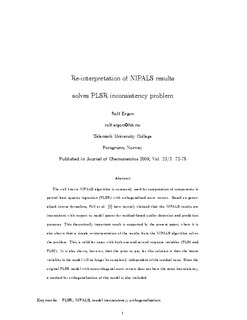| dc.contributor.author | Ergon, Rolf | |
| dc.date.accessioned | 2009-03-26T14:33:39Z | |
| dc.date.accessioned | 2017-04-19T12:49:51Z | |
| dc.date.available | 2009-03-26T14:33:39Z | |
| dc.date.available | 2017-04-19T12:49:51Z | |
| dc.date.issued | 2009 | |
| dc.identifier.citation | Journal of chemometrics 23(2009) No. 2, p. 72-75 | |
| dc.identifier.issn | 0886-9383 | |
| dc.identifier.uri | http://hdl.handle.net/11250/2438414 | |
| dc.description.abstract | The well-known nonlinear iterative partial least squares (NIPALS) algorithm is commonly used for computation of components in partial least squares regression (PLSR) with orthogonalized score vectors. Based on generalized inverse formalism, Pell et al.[1] have recently claimed that the NIPALS results are inconsistent with respect to model spaces for residual-based outlier detection and prediction purposes. This theoretically important result is supported by the present paper, where it is also shown that a simple re-interpretation of the results from the NIPALS algorithm solves the problem. This is valid for cases with both one and several response variables (PLS1 and PLS2). It is also shown, however, that the price to pay for this solution is that the latent variables in the model will no longer be completely independent of the residual noise. Since the original PLSR model with non-orthogonal score vectors does not have the same inconsistency, a method for orthogonalization of this model is also included. | |
| dc.language.iso | eng | |
| dc.publisher | Wiley | |
| dc.subject | PLSR | |
| dc.subject | NIPALS | |
| dc.subject | Model inconsistency | |
| dc.subject | Orthogonalization | |
| dc.title | Re-interpretation of NIPALS results solves PLSR inconsistency problem | |
| dc.type | Journal article | |
| dc.type | Peer reviewed | |
| dc.subject.nsi | 563 | |
| dc.identifier.doi | http://dx.doi.org/10.1002/cem.1180 | |
